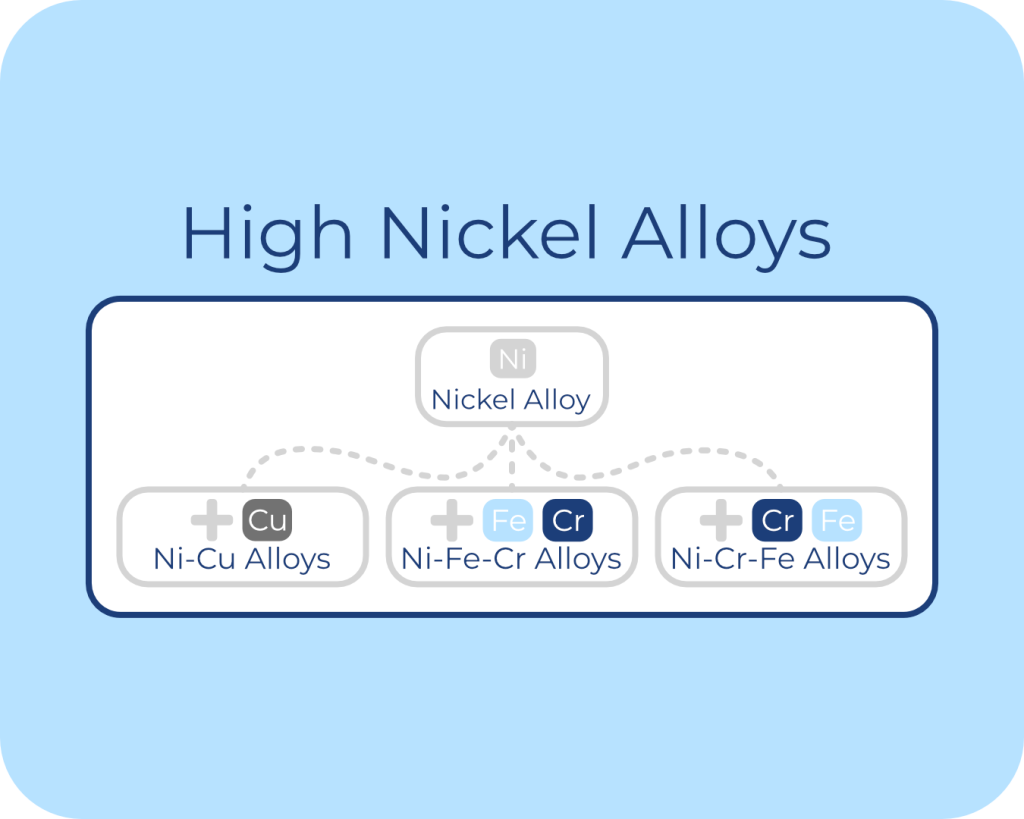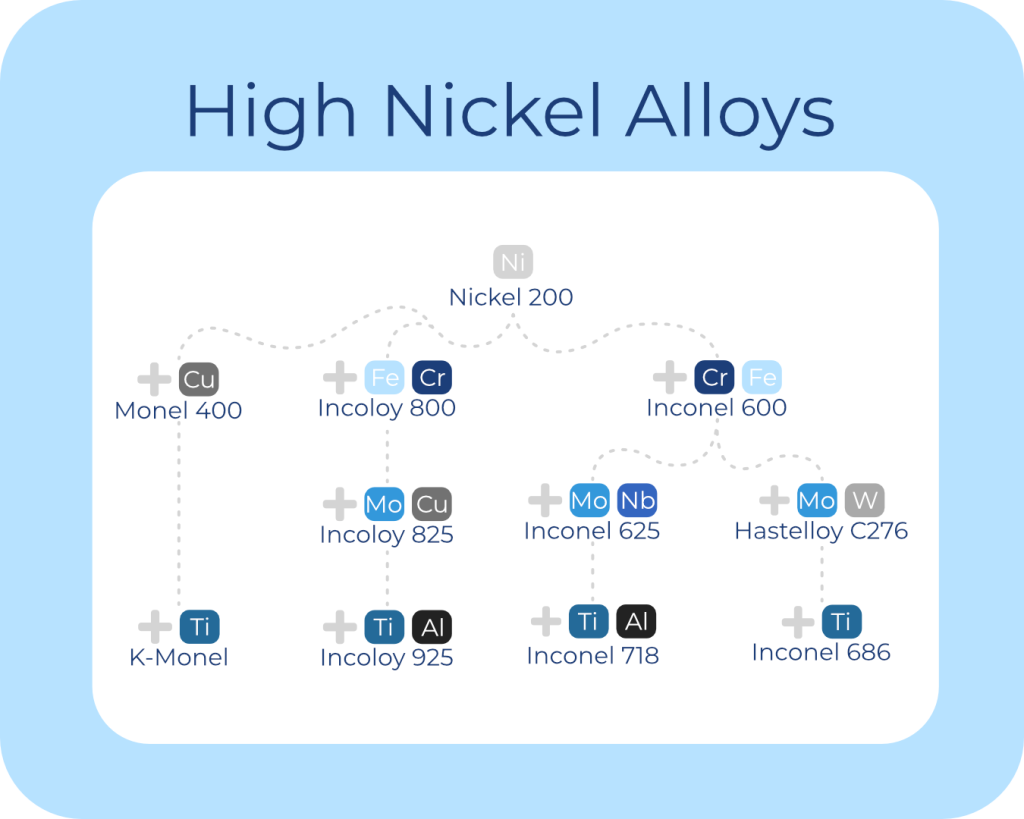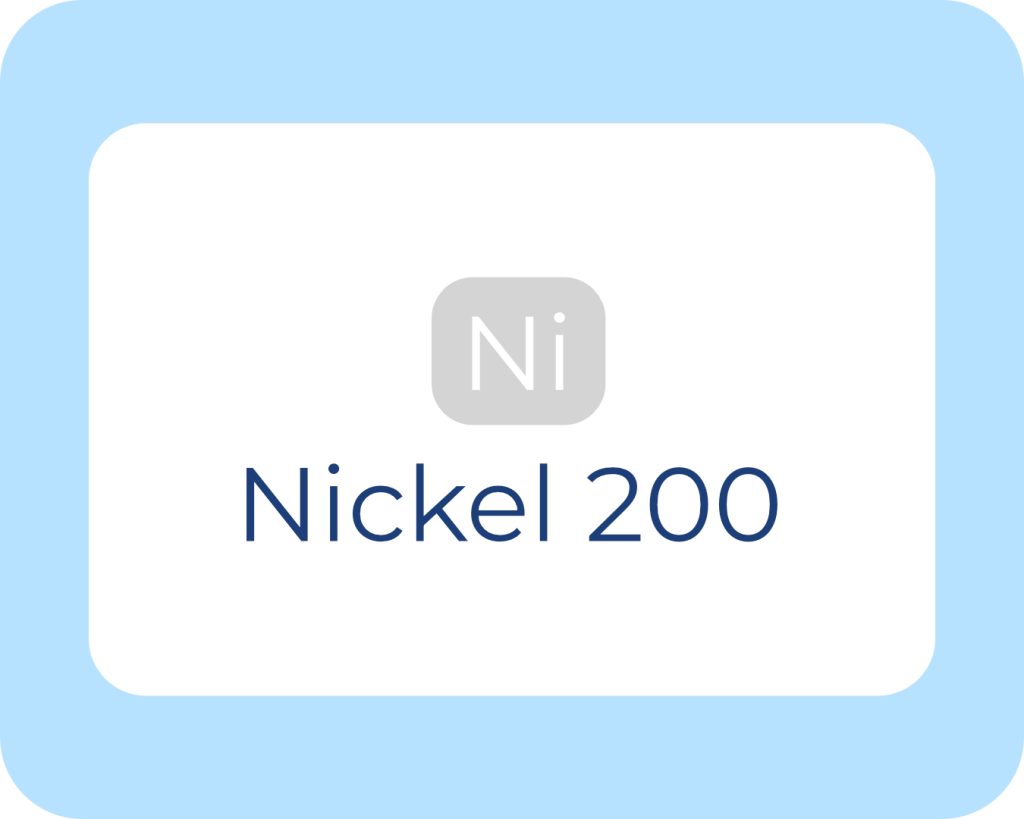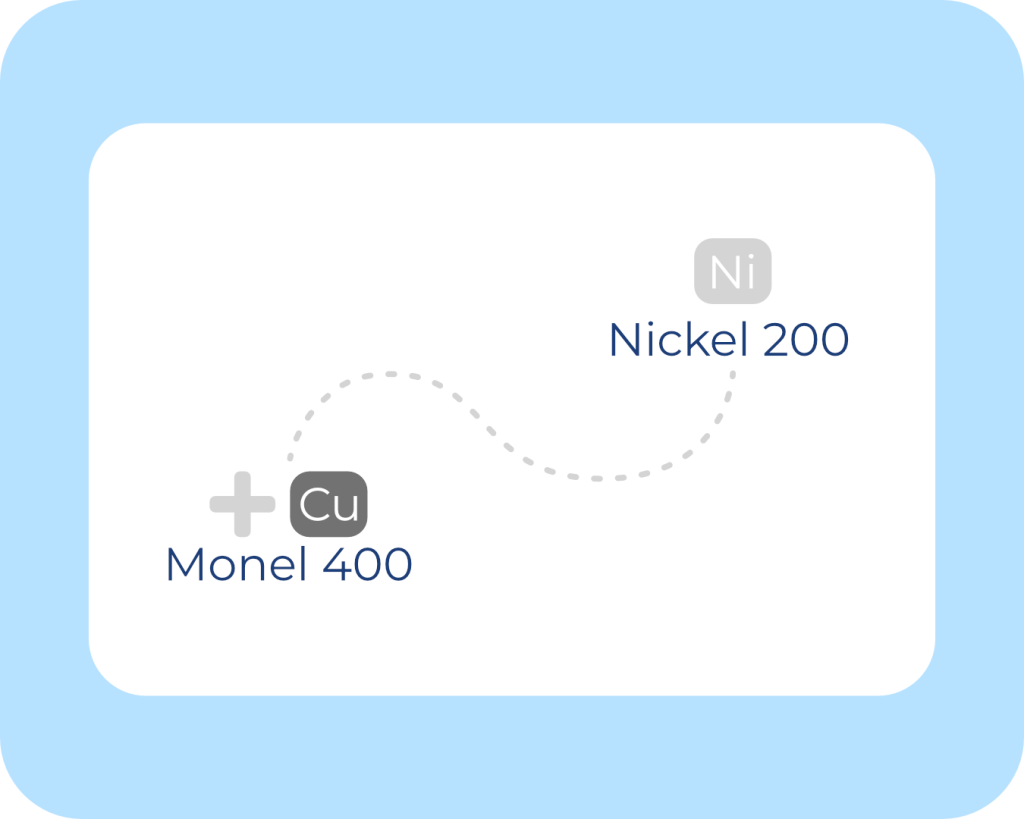

High nickel alloys are metal alloys that are built on the element, Nickel and combined with other elements resulting in powerful properties that resist the effects of extreme environments. In these alloys, Nickel is utilized as both the base and primary content element. Other elements such as copper, iron, chromium, molybdenum, aluminum, tungsten, and titanium are added leading to the alloys having exceptional strength, corrosion resistance, heat resistance and other properties that make them essential components for extreme environments. Below is a brief list and description of their characteristics.
Below is an pictorial overview of the major alloy families and their major chemical relationships:

High nickel alloys begins with a nickel base. Nickel has excellent corrosion resistance.

It inherently resists oxidation, acid attack and alkaline corrosion. It forms a stable passive oxide layer protecting against aggressive environments. It also resists chloride stress cracking. This specific characteristic separates it from stainless steels which often have this type of failure.
Nickel maintains its mechanical integrity at temperatures above 1832℉ (1000℃). It also has resists creep, deformation, and structural degradation under sustained heat loads.
Nickel supports the formation of a stable face-centered cubic crystal structure across a wide temperature range. Face-centered cubic structures are critical for corrosion resistance.
Nickel is a great element that forms a solid solution with many elements. This permits designed mechanical properties and improved corrosion resistance against specific corrosive agents such as sulfuric, nitric, and hydro chloric acids.
Nickel is ferromagnetic at room temperature. It also has low thermal expansion and good thermal conductivity. Thus, it can be used in precision engineering and aerospace applications.
We sell pure nickel as Nickel 200/201 material.
The Nickel-Copper Alloy family–also referred to as the Monel© Family–consists of the primary elements of nickel and copper. The two major types of alloys within this family are Monel© 400 and K-Monel/Monel© 500.
Here are the major characteristics of Nickel-Copper Material:
The primary characteristic of Nickel-Copper family is corrosion resistance. This material performs exceptionally well against saltwater, brine water, and in submerged conditions.
This family of materials also has very good mechanical toughness. It retains its toughness over wide temperature range, from cryogenic to moderately high temperatures (~500℃).

Monel® 400 is a part of the nickel-copper family. Its secondary element is copper. When copper is added to nickel it enhances all of its properties. Corrosion resistance is enhances as copper significantly improves resistance to chloride ions in seawater and brine making Monel 400 highly resistant to pitting, crevice, and stress corrosion cracking. Copper also helps to resist hydrofluoric and sulfuric acid and alkaline environments especially non-oxidizing acids. In these environments stainless steel often fails. Copper provides further thermal stability and conductivity preventing thermal fatigue and hot cracking. Lastly, copper strengthens through solid solution hardening. The copper atoms merge into the nickel matrix and impede dislocation motion.

In addition to copper, titanium along with aluminum may be added in the Nickel-Copper family to form K-Monel® or Monel®500. This is an aged-hardened alloy. The added titanium along with the age-hardening process adds significant strength to the alloy.
The Nickel-Iron-Chromium family is a class of high-performance austenitic alloys. Its primary composition includes nickel, iron, and chromium. This alloy family fills a gap between stainless steel and the superalloys. They are known to have exception corrosion and oxidation resistance and mechanical stability at elevated temperatures. The trademarked name related to this family is the Incoloy® alloy family.
These materials maintain their strength & ductility up to 2,1012℉ (1,100℃). They also resist creep, stress rupturing, and grain coarsening under prolonged thermal exposure.
The material chromium component forms a protective Cr₂O₃ oxide layer. Nickel provides structural stability and prevents carbide formation at the grain boundaries. This means that this material is well suited for furnace components, reformers, and petrochemical heaters.
The balance of nickel, iron, and chromium ensures a fully austenitic structure at room and elevated temperatures. This means that it has high toughness and fatigue strength. It has low susceptibility to embrittlement or cracking and good weldability.
Ni-Fe-Cr materials resist corrosion well in oxidizing and reducing environments. These environments include sulfur-bearing gases, nitric acid environments, and mildly reducing acids.

The three major elements and their composition in Incoloy® 800 are nickel at 32.5%, iron at 43.8%, and chromium at 21%. The primary benefits of iron include the stabilization of the austenitic matrix structure, stability and control of grain growth at high temperatures resisting creep deformation. It also adjusts thermal expansion and thermal fatigue resistance
Chromium creates a stable and adherent chromium oxide layer. In addition, it resists carburization in carbon-rich environments. Finally, it helps resist corrosion at high temperatures. This includes resisting sulfidation and chlorination especially in petrochemical and power industries.
The heavy amount of iron also provides cost savings benefit. Iron is a cheap filler element that reduces the overall cost and offers an alternative between the expensive high cost, high nickel alloys and the relatively cheap and cost efficient stainless steels.

Copper and molybdenum are added to Incoloy 800 along with other minor chemical adjustments to form Incoloy® 825 primarily to increase its corrosion resistance. Copper specifically adds resistance to reducing acids including sulfuric and phosphoric acid. It also further prevents pitting and crevice corrosion in acid-chloride conditions. Finally, it improves resistance in marine and brine solutions.
Molybdenum increases resistance to pitting, crevice corrosion, and stress corrosion cracking especially in chloride-rich environments. It also enables Incoloy® 825 to be suitable for aggressive mixed-acid conditions. This includes nitric and sulfuric acid solutions. Lastly, it also further enhances its performance against oxidizing and reducing environments at the same time.
